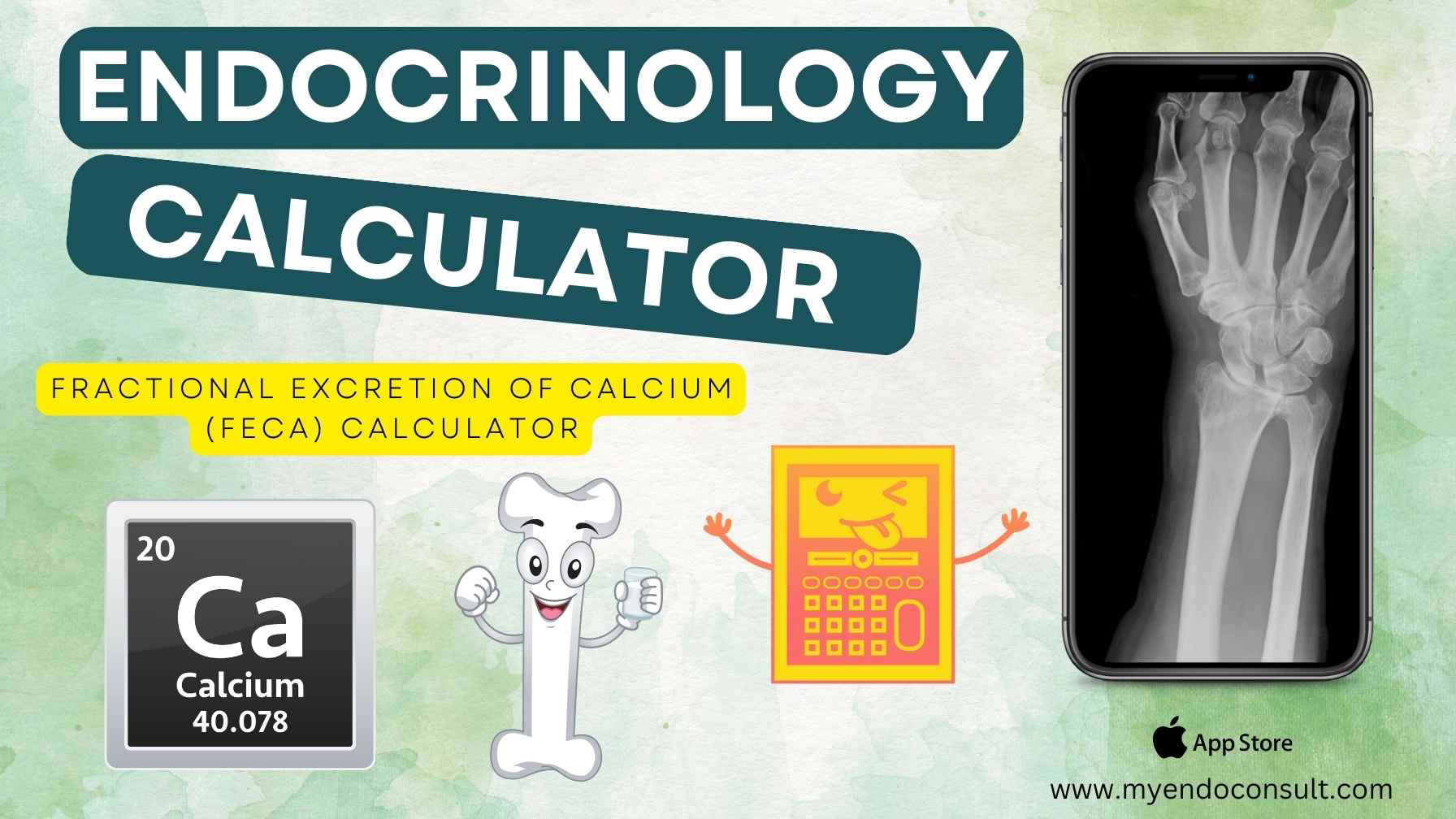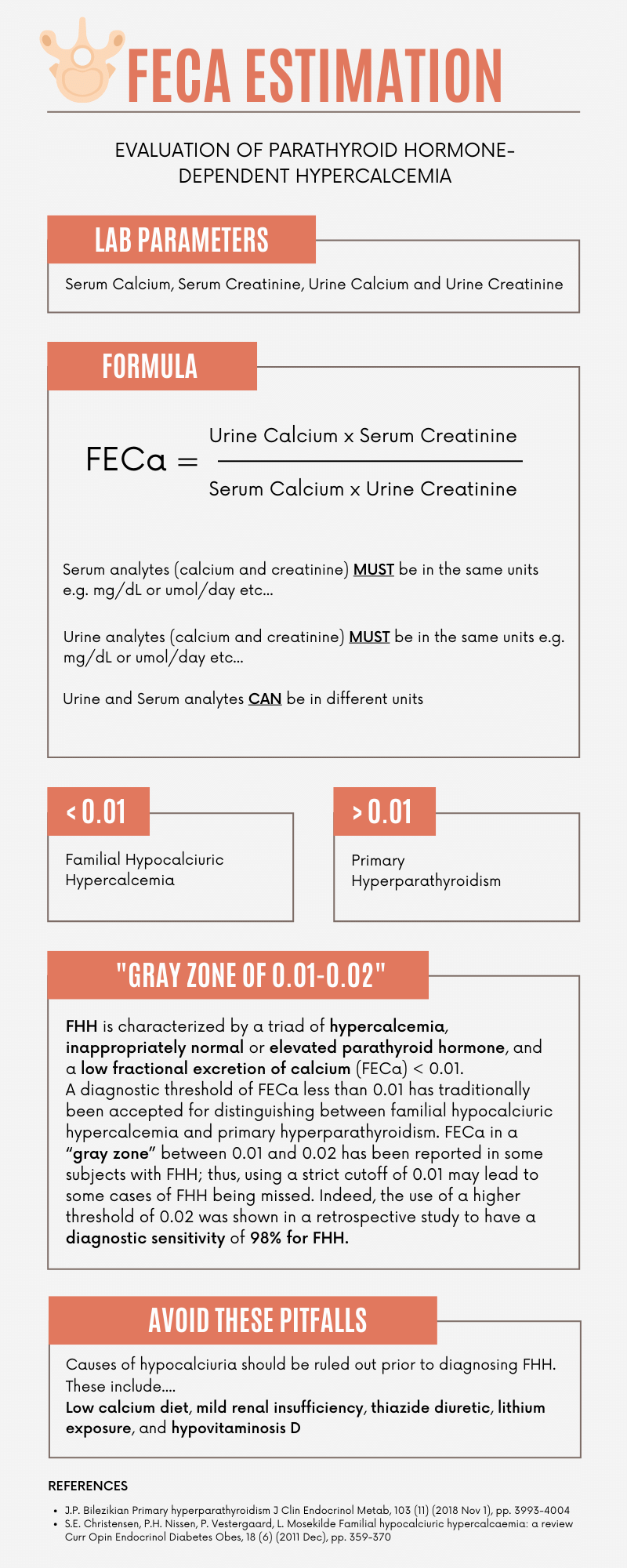
Calcium creatinine clearance ratio or FECa calculator
Please note, all units must be the same (mg/dL or umol/L). However, for 24 hour urine calcium and creatinine, you can choose either mg/dL or mg per 24 hours (concentration). Opting for urine calcium and creatinine (in mg per 24hours) will not change the final output.
Interpretation of FECa results
> 0.01: Familial Hypocalciuric Hypercalcaemia (FHH) is unlikely. The patient most likely has primary hyperparathyroidism
< 0.01: Familial Hypocalciuric Hypercalcaemia (FHH) is likely. It is however important to rule out other causes of low urine calcium excretion such as hypovitaminosis D, low salt intake, low calcium intake, significant renal disease, lithium or thiazide diuretic exposure
Differential diagnoses of PTH dependent hypercalcemia

Download a high-resolution version (pdf print version) or picture format (PNG)
The diagnostic umbrella for PTH-dependent hypercalcemia is broad, with most cases representing primary hyperparathyroidism (PHPT), after excluding other causes of hyperparathyroidism. Although a relatively rare cause of PTH-dependent hypercalcemia, misdiagnosis of a case of FHH may lead to inadvertent and possibly harmful parathyroidectomy.
FHH is characterized by a triad of hypercalcemia, inappropriately normal or elevated parathyroid hormone, and a low fractional excretion of calcium (FECa) < 0.01. A diagnostic threshold of FECa less than 0.01 has traditionally been accepted for distinguishing between familial hypocalciuric hypercalcemia and primary hyperparathyroidism. FECa in a “gray zone” between 0.01 and 0.02 has been reported in some subjects with FHH; thus, using a strict cutoff of 0.01 may lead to some cases of FHH being missed. Indeed, the use of a higher threshold of 0.02 was shown in a retrospective study to have a diagnostic sensitivity of 98% for FHH.
References
- J.P. Bilezikian Primary hyperparathyroidism J Clin Endocrinol Metab, 103 (11) (2018 Nov 1), pp. 3993-4004
- C. Brachet, E. Boros, S. Tenoutasse, W. Lissens, G. Andry, P. Martin, et al. Association of parathyroid adenoma and familial hypocalciuric hypercalcaemia in a teenager Eur J Endocrinol, 161 (1) (2009 Jul 1), pp. 207-210
- J.S. Bhangu, A. Selberherr, L. Brammen, C. Scheuba, P. Riss Efficacy of calcium excretion and calcium/creatinine clearance ratio in the differential diagnosis of familial hypocalciuric hypercalcemia and primary hyperparathyroidism Head Neck, 41 (5) (2019), pp. 1372-1378
- J.P. Bilezikian, M.L. Brandi, R. Eastell, S.J. Silverberg, R. Udelsman, C. Marcocci, et al. Guidelines for the management of asymptomatic primary hyperparathyroidism: summary statement from the fourth international workshop J Clin Endocrinol Metab, 99 (10) (2014 Oct), pp. 3561-3569
- S.E. Christensen, P.H. Nissen, P. Vestergaard, L. Mosekilde Familial hypocalciuric hypercalcaemia: a review Curr Opin Endocrinol Diabetes Obes, 18 (6) (2011 Dec), pp. 359-370
Kindly Let Us Know If This Was helpful? Thank You!



Thank you for your positive feedback!
Great tool